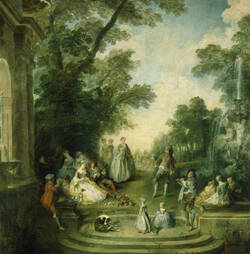The format of this painting is exceptionally large for a work of this type. Presumably the picture was part of a magnificent interior. The stage-like form of presentation in such “fêtes galantes”, already evident in the works of Watteau, is intensified still further here by the addition of stone parapets and steps in the foreground, which emphasise the perspective effect. The scene is viewed from a slightly elevated angle, which nevertheless does not explain the varying scale of the figures.
Further Media
The parkland setting may look very natural, yet at the same time, the scenery has something exceptionally artificial. Don’t the figures in the foreground seem rather like actors on the stage? Couldn’t the distant landscape be just a theatre backdrop? It is not exactly clear where reality stops and the game of courtship begins. Here, quite possibly, we are not looking at a real event, but a stage performance.
There is undoubtedly a connection to the theatre, since the genre of the fête galante was heavily influenced by the traditional form of improvised theatre in Italy – the commedia dell’arte. The commedia dell’arte figures and costumes were exceptionally popular in eighteenth-century Paris.
The colourful ambiguity is, in any case, a main feature of rococo art, a stylistic era roughly between 1710 and 1770.
- Location & Dating
- 1725 (?)
- Material & Technique
- Oil on canvas
- Dimenions
- 207 x 207 cm
- Museum
- Gemäldegalerie Alte Meister
- Inventory number
- Gal.-Nr. 784

